Table of Contents
- Understanding Your Pickleball Court Construction Costs Outline
- Understanding Pickleball Court Construction Costs Outline
- Pickleball Court Dimensions and Key Definitions
- Durability, Playability, and Cost-Effectiveness Principles
- Essential Pickleball Court Construction Components
- Pickleball Court Dimensions and Layout Considerations
- Pickleball Court Surface Material and Drainage Costs
- Pickleball Court Fencing Height and Material Options
- Pickleball Court Lighting Type and Intensity Costs
- Pickleball Court Amenities: Benches and Storage Costs
- Indoor vs. Outdoor Pickleball Court Cost Differences
- Single vs. Multi-Court Pickleball Complex Costs
- DIY vs. Professional Pickleball Court Installation Costs
- Detailed Pickleball Court Construction Costs Outline
- Preparation: Materials for Pickleball Court Construction Costs
- Initial Setup: Site Assessment Affecting Pickleball Costs
- Considerations: Regulations Impacting Pickleball Court Costs
- Step-by-Step: Constructing a Pickleball Court Affordably
- Best Practices: Ensuring Quality Pickleball Court Construction
- Common Mistakes: Avoiding Pitfalls in Pickleball Court Builds
- Advanced Techniques: Optimizing Pickleball Court Construction Costs
- Optimization: Reducing Overall Pickleball Court Construction Costs
- Troubleshooting: Addressing Common Pickleball Court Problems
- Understanding Pickleball Court Construction Costs Outline
- Pickleball Court Construction Costs: Material Selection
- Asphalt Court Surface Costs and Considerations
- Concrete Court Surface Costs and Durability
- Plastic Tile Court Surface Costs and Versatility
- Polyurethane Court Surface: Ideal for Indoor Play
- Acrylic Court Surface Costs: Basic vs. Cushioned
- Chain-Link Fencing Costs for Pickleball Courts
- Premium Vinyl-Coated Fencing Costs for Pickleball Courts
- Pine and Composite Fencing Costs for Pickleball Courts
- Single-Pole Lighting Costs for Pickleball Courts
- Tournament-Style Lighting Costs for Pickleball Courts
- LED vs. Metal Halide Lighting Costs and Efficiency
- Pickleball Court Construction Costs Outline: Indoor vs. Outdoor
- Pickleball Court Construction Costs Outline: Additional Amenities
- Pickleball Court Construction Costs Outline: Selecting the Right Contractor
- Pickleball Court Construction Costs Outline: Key Takeaways
- Concluding Thoughts on Pickleball Court Construction Costs Outline
- Pickleball Court Construction Costs Outline: Helpful Resources
Understanding Your Pickleball Court Construction Costs Outline
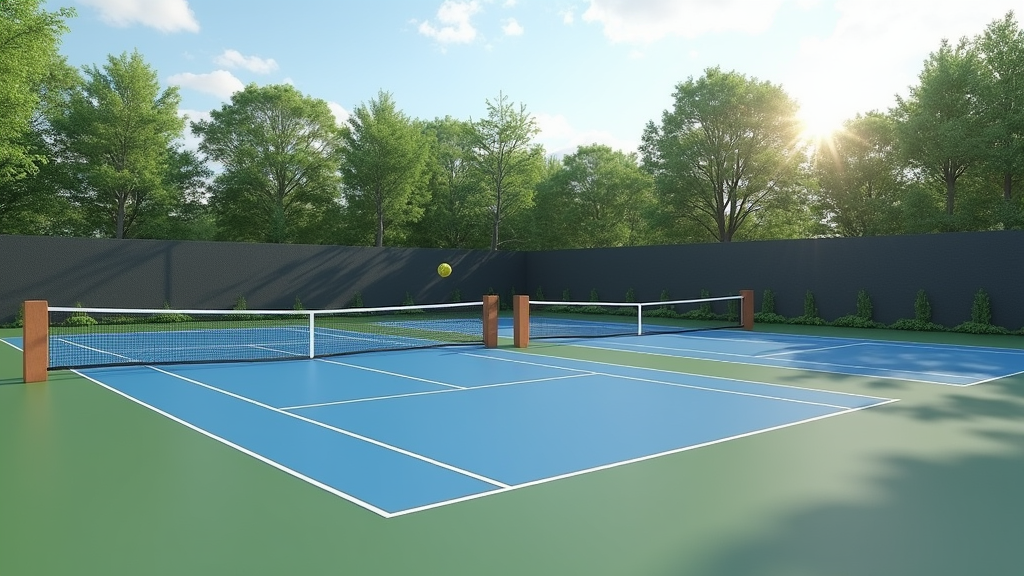
Pickleball Court Construction Cost: Project Planning Importance
Pickleball’s explosive growth across the nation is fueling a significant rise in the demand for dedicated pickleball courts. As more communities, clubs, and individuals seek to build their own courts, understanding the intricacies of pickleball court construction costs becomes paramount. This understanding is not just about knowing the bottom line; it’s about strategic budgeting, informed decision-making, and ensuring a successful project from start to finish.
Pickleball participation has seen a dramatic surge, with some reports indicating increases of over 30% in recent years. This popularity underscores the need for more courts and highlights the importance of carefully planning and budgeting for their construction.
A comprehensive understanding of construction costs allows you to accurately estimate the total project expense, make informed choices about materials and features, and ultimately avoid costly budget overruns. Whether you’re planning a simple backyard court or a multi-court facility, this knowledge is essential.
Pickleball Court Construction Costs: Historical Context
Pickleball, invented in 1965, started as a backyard game but has evolved into a nationally recognized sport. Its recent surge in popularity has led to increased demand for dedicated pickleball courts, driving innovation in construction technologies and evolving court standards.
From humble beginnings, pickleball has transformed into a mainstream activity, prompting advancements in court surfacing, lighting, and overall design. Keeping abreast of these developments is crucial for anyone considering pickleball court construction.
Key Aspects of Pickleball Court Construction Costs
This guide will provide you with the core concepts necessary to understand the factors influencing pickleball court construction costs. You’ll learn how to estimate expenses, choose appropriate materials, and identify opportunities to save money without compromising quality.
Our aim is to equip you with the practical knowledge needed to confidently navigate the pickleball court construction process, ensuring you can create a court that meets your needs and budget.
Understanding Pickleball Court Construction Costs Outline
Pickleball Court Dimensions and Key Definitions
Before diving into the costs, it’s crucial to understand the basics. A standard pickleball court measures 20 feet wide and 44 feet long. The non-volley zone, often called the “kitchen,” extends 7 feet from the net on each side. For comfortable play, a playing area of at least 30 feet by 60 feet is recommended, though tournament-level courts often require 34 feet by 64 feet.
Durability, Playability, and Cost-Effectiveness Principles
When planning a pickleball court, the core principles to keep in mind are durability, playability, and cost-effectiveness. A durable court will withstand the elements and frequent use, reducing long-term maintenance costs. Playability ensures a safe and enjoyable experience for players. Balancing these with your budget is key to a successful project.
Essential Pickleball Court Construction Components
Several elements are essential for a functional pickleball court. These include the court surface, the net and posts, and optionally, fencing and lighting. Each component contributes significantly to the overall cost, so careful consideration is important.
Pickleball Court Dimensions and Layout Considerations
The dimensions and layout are primary aspects that impact the construction costs outline. Adhering to standard pickleball court dimensions ensures fair play and prevents future modifications. Proper layout planning optimizes space and player movement.
Pickleball Court Surface Material and Drainage Costs
The choice of surface material—asphalt, concrete, acrylic, or synthetic—significantly affects the overall cost and playability. Outdoor courts also require effective drainage systems to prevent water damage and ensure year-round usability.
Pickleball Court Fencing Height and Material Options
Fencing is optional but highly recommended, especially for outdoor courts, to contain the ball and prevent interference. Options include chain-link and vinyl-coated fences, with varying heights and material costs.
Pickleball Court Lighting Type and Intensity Costs
Lighting is essential for evening play and extends the usability of the court. Options range from single-pole lighting to more intense, tournament-style lighting systems, each with different installation costs.
Pickleball Court Amenities: Benches and Storage Costs
Adding amenities like benches and storage can enhance the player experience but also add to the overall construction costs. These are secondary considerations but contribute to a more comfortable and functional pickleball court.
Indoor vs. Outdoor Pickleball Court Cost Differences
The location, whether indoor or outdoor, significantly impacts the construction costs outline. Indoor courts may require additional ventilation and specialized flooring, while outdoor courts need to withstand weather elements and require proper drainage.
Single vs. Multi-Court Pickleball Complex Costs
Building a single court versus a multi-court complex has a substantial impact on the budget. Multi-court complexes may offer economies of scale but require more extensive planning and larger initial investment.
DIY vs. Professional Pickleball Court Installation Costs
Choosing between DIY and professional installation is a crucial decision. DIY installation can save on labor costs but requires expertise and time. Professional installation ensures quality and adherence to standards but comes at a higher price.
Detailed Pickleball Court Construction Costs Outline
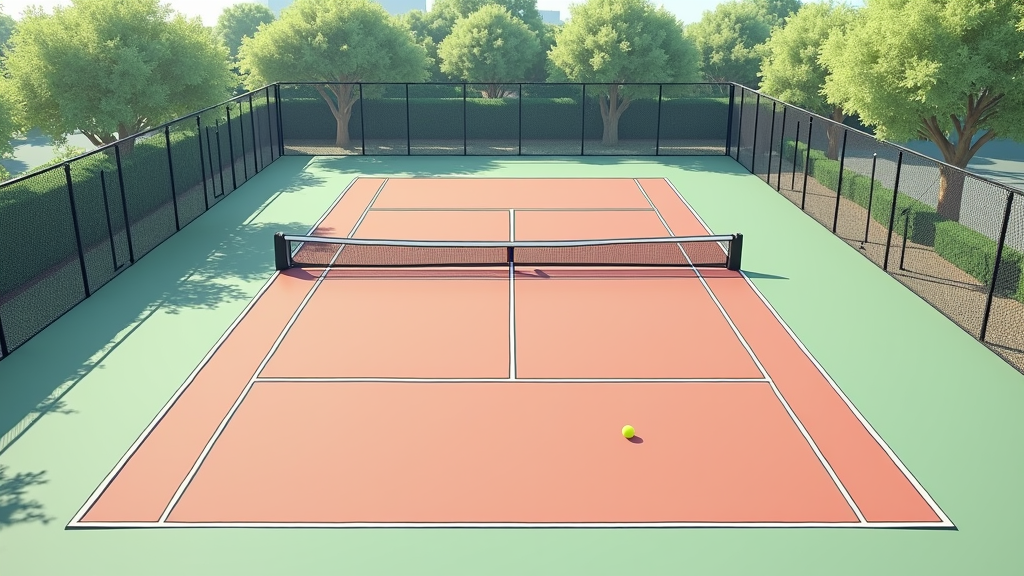
Preparation: Materials for Pickleball Court Construction Costs
Preparing for pickleball court construction involves gathering essential materials. These include the surface material (asphalt, concrete, acrylic, or synthetic), net and posts (steel or aluminum), fencing materials (chain-link or vinyl-coated), and lighting fixtures (LED or metal halide). You’ll also need tools like a measuring tape, level, and potentially a concrete mixer or paving equipment.
- Surface Material: Asphalt, Concrete, Acrylic, Synthetic
- Net and Posts: Steel, Aluminum
- Fencing Materials: Chain-Link, Vinyl-Coated
- Lighting Fixtures: LED, Metal Halide
Initial Setup: Site Assessment Affecting Pickleball Costs
The initial setup is crucial. This involves a thorough site assessment and preparation, including land clearing and leveling. Soil stabilization might be necessary depending on the location. Consider local zoning regulations, permits, soil conditions, drainage, and your budget constraints during this phase.
- Site Assessment and Preparation
- Land Clearing and Leveling
- Soil Stabilization (if necessary)
Considerations: Regulations Impacting Pickleball Court Costs
Several factors influence the overall pickleball court construction costs outline. Local zoning regulations and permit requirements can add to the expense. The existing soil conditions and the need for proper drainage solutions also play a significant role. Finally, keeping a close eye on budget constraints is essential to avoid overspending.
- Local Zoning Regulations and Permits
- Soil Conditions and Drainage
- Budget Constraints
Step-by-Step: Constructing a Pickleball Court Affordably
Constructing a pickleball court involves several key steps. First, layout and mark the court boundaries (20′ x 44′ playing area, 30′ x 60′ recommended total area). Next, prepare the base by excavating and leveling the area. Install the surface material by pouring concrete or asphalt, or installing modular tiles. Install the net posts and net (36 inches at sidelines, 34 inches in the middle). Optionally, install fencing and lighting fixtures. Finally, paint the court lines according to USA Pickleball Association standards.
Best Practices: Ensuring Quality Pickleball Court Construction
To ensure a high-quality pickleball court, follow best practices. Ensure proper drainage to prevent water damage. Use high-quality materials for durability. Adhere to USA Pickleball Association guidelines for court dimensions and line markings.
- Ensure proper drainage to prevent water damage.
- Use high-quality materials for durability.
- Follow USA Pickleball Association guidelines for court dimensions and line markings.
Common Mistakes: Avoiding Pitfalls in Pickleball Court Builds
Avoid common mistakes during construction. Poor site preparation can lead to uneven surfaces. Inadequate drainage can cause water damage. Incorrect line markings can affect gameplay.
- Poor site preparation leading to uneven surfaces.
- Inadequate drainage.
- Incorrect line markings.
Advanced Techniques: Optimizing Pickleball Court Construction Costs
For advanced techniques, consider post-tension concrete for maximum durability. Use cushioned acrylic surfacing for improved player comfort. Install LED lighting for energy efficiency and a long lifespan.
- Consider post-tension concrete for maximum durability.
- Use cushioned acrylic surfacing for improved player comfort.
- Install LED lighting for energy efficiency and long lifespan.
Optimization: Reducing Overall Pickleball Court Construction Costs
Optimize costs by building multiple courts at once to reduce the per-court expense. Convert existing tennis or basketball courts for cost savings. Choose cost-effective surface materials like asphalt for budget projects.
- Build multiple courts at once to reduce costs per court.
- Convert existing tennis or basketball courts for cost savings.
- Choose cost-effective surface materials like asphalt for budget projects.
Troubleshooting: Addressing Common Pickleball Court Problems
Address common problems such as drainage issues, cracks in asphalt or concrete surfaces, and lighting adjustments for optimal visibility.
- Addressing drainage issues.
- Repairing cracks in asphalt or concrete surfaces.
- Adjusting lighting for optimal visibility.
Understanding Pickleball Court Construction Costs Outline
Factors Influencing Pickleball Court Construction Cost Outline
Several factors significantly impact the overall cost of pickleball court construction. These include court size, the type of base material used, fencing options, site conditions, surfacing material, lighting choices, and the location of the court.
- Court Size:Standard pickleball courts (20′ x 44′) will naturally cost less than larger courts (30′ x 60′ or 34′ x 64′).
- Base Material:Post-tension concrete is generally more expensive than rebar-reinforced concrete or asphalt.
- Fencing:Basic chain-link fencing (4ft high) is more affordable than premium vinyl-coated fencing (10ft high).
- Site Conditions:Flat terrain is easier and cheaper to work with than hilly terrain, which may require additional grading and preparation. Soil conditions can also impact foundation costs.
- Surfacing:Basic acrylic surfacing is the least expensive option, while cushioned acrylic or modular interlocking tiles will increase the cost.
- Lighting:Single-pole lighting is a more budget-friendly option compared to tournament-style lighting systems.
- Location:Urban areas tend to have higher permit fees, labor costs, and land costs compared to suburban or rural areas.
Estimated Pickleball Court Construction Costs Breakdown
Here’s a breakdown of estimated costs associated with pickleball court construction. These figures are approximate and can vary depending on the factors mentioned above.
- Basic DIY Court:$600-$1,200 (includes surface preparation, net, and posts).
- Standard Outdoor Court:
- Premium Indoor Court:
- Overall Cost Ranges:
- Surface: $4-$8 per square foot.
- Net: $100-$200.
- Posts: $100-$200 per post.
- Lighting: $50-$100 per fixture.
- Fencing: $15-$25 per linear foot.
- Surface: $6-$10 per square foot.
- Net: $150-$250.
- Posts: $150-$250 per post.
- Lighting: $100-$200 per fixture.
- Fencing: $25-$35 per linear foot.
- Benches: $200-$400 per bench.
- Storage: $400-$800 per unit.
- Basic Court: $3,000 – $12,000
- Standard, High-Quality Court: $35,000 – $80,000
- 8-Court Outdoor Complex: $300,000 (approximate)
Strategies for Pickleball Court Construction Cost Savings
There are several strategies you can employ to reduce the overall cost of pickleball court construction without sacrificing quality.
- Choose Cost-Effective Surface Materials:Opting for asphalt as the base material and basic acrylic surfacing can significantly lower costs.
- Build a Smaller Court:If space is a constraint, consider building a court that meets the minimum size requirements.
- DIY Construction:If you have experience with construction projects, tackling some of the work yourself can save on labor costs.
- Convert Existing Courts:Converting an existing tennis or basketball court into a pickleball court is often more affordable than building a new court from scratch.
- Build Multiple Courts Simultaneously:If you’re planning to build multiple courts, doing so at the same time can reduce mobilization costs and potentially qualify you for bulk discounts on materials.
Pickleball Court Construction Costs: Material Selection
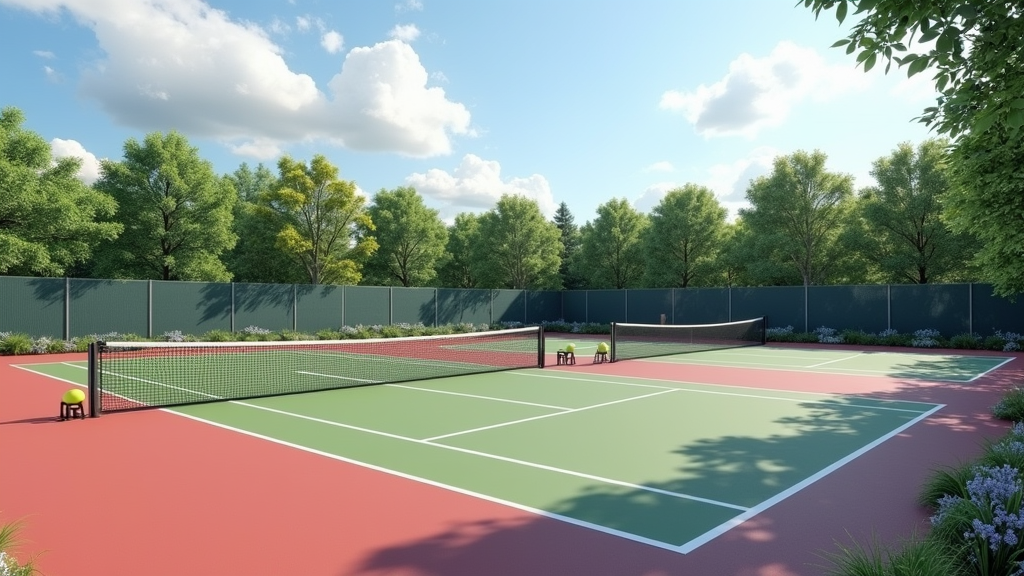
Asphalt Court Surface Costs and Considerations
Asphalt is often chosen for outdoor pickleball courts due to its affordability. Initial costs range from $8 to $12 per square foot. However, be aware that asphalt requires more frequent maintenance to prevent cracking and ensure a smooth playing surface over time.
Concrete Court Surface Costs and Durability
Concrete is another popular choice for outdoor pickleball courts, offering enhanced durability compared to asphalt. Expect to pay between $10 and $15 per square foot for a concrete pickleball court. While the initial investment is higher, the longevity of concrete can make it a cost-effective option in the long run.
Plastic Tile Court Surface Costs and Versatility
Plastic tiles provide versatility as they are suitable for both indoor and outdoor pickleball courts. However, this versatility comes at a premium. The cost for a full pickleball court using plastic tiles can easily exceed $15,000, making it one of the more expensive surface options.
Polyurethane Court Surface: Ideal for Indoor Play
Polyurethane surfaces are commonly used for indoor pickleball courts, offering a high-quality finish that provides excellent playability and comfort. While specific pricing can vary, polyurethane is generally considered a premium indoor surface option.
Acrylic Court Surface Costs: Basic vs. Cushioned
Acrylic surfaces are a popular choice for pickleball courts, with costs varying based on the level of cushioning. A basic acrylic surface typically ranges from $5,000 to $7,000, while a cushioned acrylic surface can cost between $10,000 and $15,000. The added cushioning enhances player comfort and reduces the impact on joints.
Chain-Link Fencing Costs for Pickleball Courts
Basic chain-link fencing, typically 4 feet high, is a cost-effective option for enclosing a pickleball court. Expect to pay approximately $35 per linear foot for this type of fencing. It provides adequate containment for pickleballs while keeping costs down.
Premium Vinyl-Coated Fencing Costs for Pickleball Courts
For a more aesthetically pleasing and durable fencing option, consider premium vinyl-coated fencing, often 10 feet high. This type of fencing comes at a higher price point, approximately $125 per linear foot, but offers enhanced visual appeal and longevity.
Pine and Composite Fencing Costs for Pickleball Courts
For a more private and visually appealing pickleball court enclosure, pine or composite fencing is an option. The total cost for this type of fencing typically ranges from $5,000 to $15,000, depending on the materials used, height, and overall design.
Single-Pole Lighting Costs for Pickleball Courts
A basic single-pole lighting system for a pickleball court typically costs around $2,500. This provides adequate illumination for recreational play but may not be sufficient for competitive matches.
Tournament-Style Lighting Costs for Pickleball Courts
For pickleball courts hosting tournaments or requiring high-level illumination, tournament-style lighting is necessary. This type of lighting system can cost around $12,500, providing optimal visibility for players and spectators.
LED vs. Metal Halide Lighting Costs and Efficiency
When choosing lighting for your pickleball court, consider the energy efficiency and lifespan of different options. LED lighting is more energy-efficient and has a longer lifespan compared to traditional metal halide lighting, potentially leading to long-term cost savings despite a higher initial investment.
Pickleball Court Construction Costs Outline: Indoor vs. Outdoor
Outdoor Pickleball Court Construction: Cost Factors
Outdoor pickleball courts are a popular choice, especially in regions with temperate climates. However, building and maintaining an outdoor court presents unique cost considerations. The elements can be harsh on the court surface, leading to faster wear and tear. Regular maintenance, such as cleaning and resurfacing, becomes essential to prolong the court’s lifespan and maintain optimal playing conditions.
Furthermore, proper drainage is crucial for outdoor courts to prevent water damage and ensure safe play. Installing a suitable drainage system will add to the initial construction costs.
- Better suited for temperate climates
- Subject to more wear and tear, increasing maintenance expenses
- Requires investment in drainage solutions to manage rainwater
Indoor Pickleball Court Construction: Cost Implications
Indoor pickleball courts offer a climate-controlled environment, making them ideal for regions with colder climates or for players who prefer year-round play. While indoor courts require less maintenance compared to outdoor courts due to protection from the elements, the initial construction costs can be significantly higher.
The primary cost driver for indoor courts is the need for an enclosed structure, which can be a pre-engineered building or a conversion of an existing space. This structure must provide adequate lighting, ventilation, and temperature control. APX Construction Group specializes in constructing indoor pickleball courts, offering expertise in these complex builds.
- Suited for colder climates and year-round play
- Requires less frequent maintenance due to environmental protection
- Demands a substantial investment in an enclosed structure
- APX Construction Group provides specialized indoor court construction services
Pickleball Court Construction Costs Outline: Additional Amenities
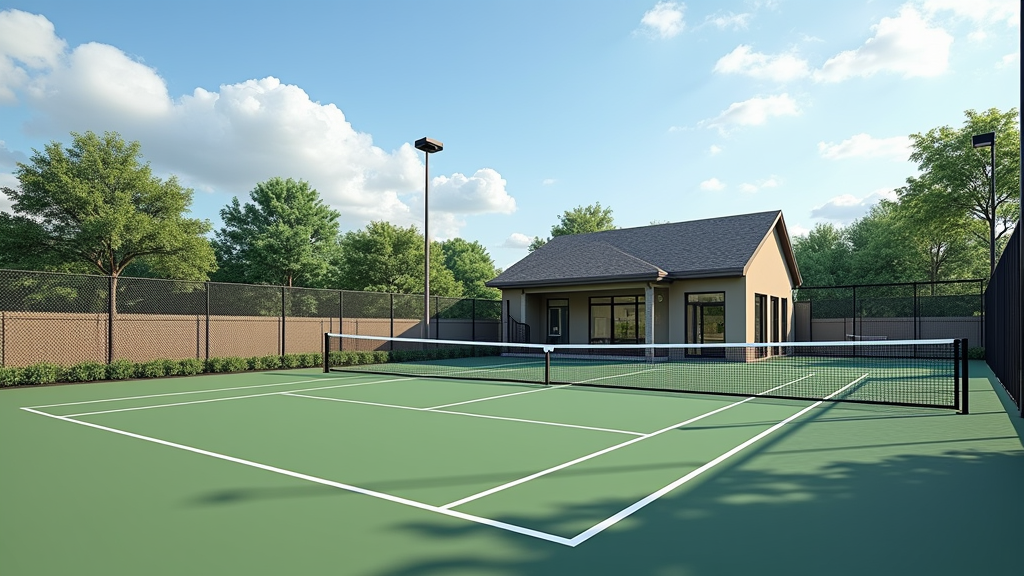
Essential Pickleball Court Amenities and Cost
Beyond the basic court surface, net, and lines, certain amenities are considered essential for a quality pickleball experience. These contribute significantly to the overall functionality and enjoyment of the court.
- Net System:A durable and regulation-height net system typically ranges in cost from $600 to $1,000, depending on the quality of materials and construction.
- Fencing (Outdoor Courts):Fencing is crucial for containing the ball and preventing interruptions. Costs vary greatly depending on the height, material (chain-link, vinyl, etc.), and length required to enclose the court.
- Lighting (Indoor and Outdoor Courts):Adequate lighting is essential for evening play. The cost of lighting systems can range from a few thousand dollars for basic setups to significantly more for professional-grade, energy-efficient options.
Optional Pickleball Court Amenities and Cost
While not strictly necessary, optional amenities can greatly enhance the comfort, convenience, and overall appeal of a pickleball court. These additions often contribute to a more premium playing experience.
- Restrooms and Locker Rooms:Adding restroom and locker room facilities involves significant construction costs, including plumbing, electrical work, and building materials. The price depends heavily on the size, features, and location of these facilities.
- Gear Storage:Providing storage solutions like cubbies or hooks for players to store their paddles, bags, and other gear adds convenience and organization. Costs are relatively low compared to other amenities.
- Benches for Viewing and Resting:Benches offer a place for players to rest between games and for spectators to watch. The cost depends on the number of benches, materials (wood, metal, recycled plastic), and style.
- Tables Outside the Court:Picnic tables or other outdoor tables provide a space for players to socialize and enjoy refreshments. The cost depends on the table size, material, and quantity.
- Cushioning or Cushion Systems:Adding a cushioned surface beneath the acrylic topcoat can significantly reduce joint stress and improve player comfort. These systems can cost several thousand dollars, depending on the size of the court and the type of cushioning material used.
Pickleball Court Construction Costs Outline: Selecting the Right Contractor
Importance of Professional Pickleball Court Installation
Engaging a professional for pickleball court installation is crucial to ensure proper construction and adherence to industry standards. This approach minimizes the likelihood of future problems, potentially saving you from costly repairs down the line. A professionally installed court provides a better playing experience and extends the lifespan of your investment.
Professional installation labor typically accounts for 10% to 20% of the total materials costs. While it may seem tempting to cut costs by doing it yourself, the expertise of a qualified contractor is invaluable in achieving a durable and regulation-compliant pickleball court.
Essential Tips for Choosing a Pickleball Court Contractor
Selecting the right contractor is a vital step in your pickleball court construction project. Here are some tips to guide you through the selection process:
- Seek recommendations from friends, family, or local pickleball communities and read online reviews to gauge the contractor’s reputation.
- Confirm that the contractor is properly licensed and insured to protect yourself from liability.
- Verify their experience in building pickleball courts specifically, and assess their overall professionalism. Ask for references and examples of past projects.
- Assess their reliability in communication and project management. A responsive and organized contractor will make the construction process smoother.
- Get multiple quotes from different contractors to compare pricing and services offered. Don’t automatically choose the lowest bid; consider the overall value and quality of work.
Pickleball Court Construction Costs Outline: Key Takeaways
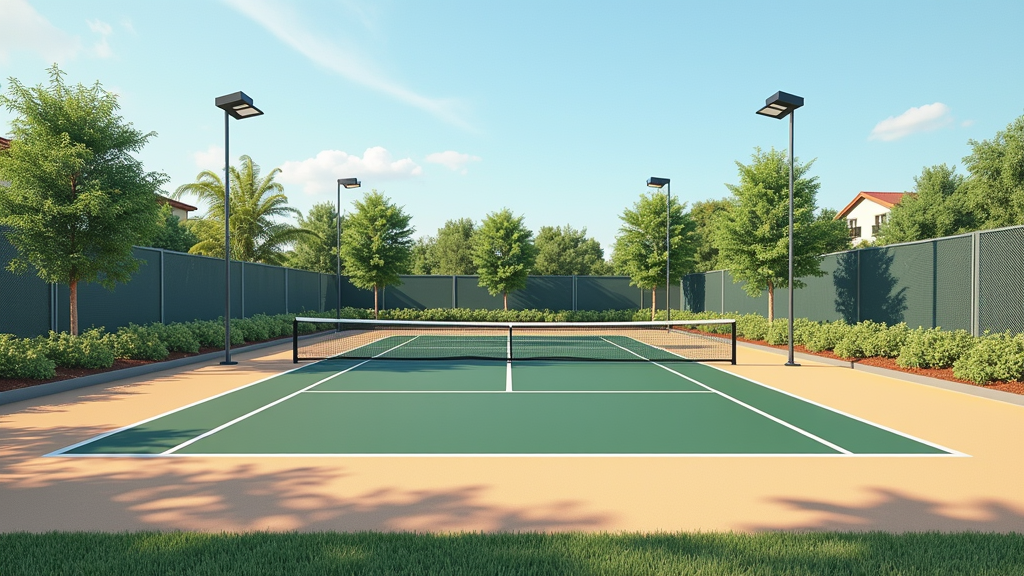
Recap of Pickleball Court Construction Cost Factors
Pickleball court construction costs vary widely depending on several factors, including the court type (indoor or outdoor), size, materials used, location, and any additional features like lighting or fencing. Careful consideration of these elements is essential for accurate budgeting.
Importance of Planning and Material Selection
Proper planning and material selection are crucial for staying within your budget. Choosing durable, weather-resistant materials for outdoor courts or specialized flooring for indoor courts can impact the overall cost and longevity of your pickleball court.
Benefits of Professional Pickleball Court Installation
Professional installation is highly recommended for optimal results. While DIY options might seem cost-effective, experienced contractors ensure proper court dimensions, surface leveling, and drainage, preventing costly repairs down the line.
Concluding Thoughts on Pickleball Court Construction Costs Outline
Securing Accurate Pickleball Court Cost Estimates
Consult with local construction companies specializing in sports facilities to obtain precise cost estimates tailored to your specific needs and location. Getting multiple quotes allows you to compare pricing and services offered.
Balancing Durability and Pickleball Court Maintenance Costs
Consider long-term durability and maintenance costs when choosing materials. While cheaper options might save money initially, they could require more frequent repairs or replacements, ultimately increasing the total cost of ownership.
Prioritizing Safety and Playability in Court Design
Prioritize safety and playability when designing your pickleball court. Ensure adequate space around the court, non-slip surfaces, and proper lighting to create a safe and enjoyable playing environment for all users.
Pickleball Court Construction Costs Outline: Helpful Resources
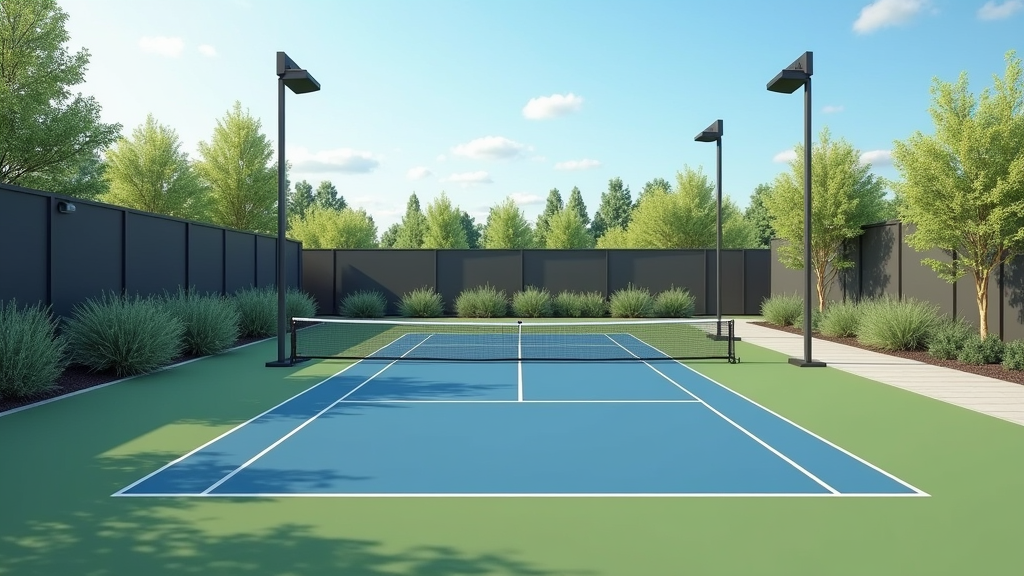
USA Pickleball Association Guidelines and Standards
Refer to the USA Pickleball Association guidelines for official court dimensions, regulations, and best practices. These guidelines ensure your court meets the standards for competitive play and recreational use.
Finding Local Pickleball Court Construction Specialists
Connect with local construction companies that specialize in sports facilities. Their expertise in pickleball court construction can help you navigate the complexities of the project and ensure a high-quality result.
APX Construction Group for Indoor Pickleball Courts
For indoor pickleball court construction, consider APX Construction Group, which specializes in building high-quality sports facilities. They can provide expert guidance on indoor court design, flooring, and lighting options.

